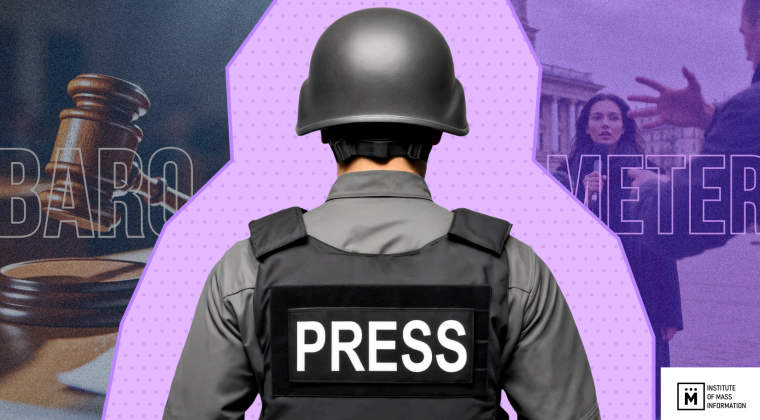Law enforcement and the judiciary are covered in an unbalanced manner in the regional media. More than two-thirds of mentions of law enforcement and the courts of justice are the press releases speaking of criminal news and reports of successful activity. At the same time, corruption and other offenses by law enforcement agencies and the judiciary are the least covered in the regional online media (only 3% of the total number of mentions). These are the results of the IMI survey conducted in April 2021 in 10 regions of Ukraine *.
According to the survey, 47% of regional media mentions of law enforcement and the judiciary speak of the national police. At the second place, it was the road police, which is mentioned in 17.5% of cases, followed by the courts (15%) and the prosecutor’s office (13.5% of all mentions of law enforcement agencies). The lowest number of mentions falls on the SBU (3.8% of the total number of mentions of law enforcement agencies), State Bureau of Investigations (2%) and National Anti-corruption Bureau of Ukraine (1% of mentions). Such results make us suppose that the press services of the National Police make the most active efforts in communicating with mass media, sending press releases about criminal news, photos and details of crimes. Online media always actively take such content, and as a result, the National Police has the most visible coverage in the regional media compared to other law enforcement agencies and even the courts.
This assumption is confirmed, if we look at the results of a study on sources of information in the news on law enforcement. It turns out that 65% of such news is based on official information (press releases, data from law enforcement websites). 12% of news about law enforcement agencies and courts are taken by regional media in other media, 10% were taken from social networks. And only 8% are the product of its journalist. We could suppose that such a small percentof its own news is a consequence of quarantine restrictions and the fact that newsrooms operate remotely. However, unfortunately, very little number of its own news product is the trend that IMI has been recording in the last few years in regional online media.
And 4% of news on law enforcement agencies and courts in the regional media did not mention any source of information at all, which is a gross violation of the professional journalistic standard of credibility.
The most popular topic were criminal news: they accounted for 53% of all mentions of law enforcement and the judiciary. And half of such news covered the National Police. Another 20% of news about the crime came to the media from the press services of the road police, and 16% were from the prosecutor’s office. The SBI and NABU appeared the least in the criminal news (1% each).
Interestingly, the news of successful activities accounted for as much as 25% of the total number of materials with mentions of law enforcement agencies and courts. The national police was also mentioned most often in such news (50% of the positive news fell on it, and again due to the fact that the news was based on press releases). The second position was up to the road police (19%) was and, not surprisingly, the regional courts (12%). NABU (1%) was rarely mentioned in success reports.
In topics related to high-profile cases, law enforcement agencies and the judiciary appeared on average in 12% of the news. The courts (43%, due to the case of Sternenko and others), the national police (25% of mentions) and the Prosecutor’s Office (17% of mentions) were most often mentioned in this topic. SBI (1% of mentions) appeared in the news the least often.
The news about law enforcement and the courts of justice could hardly be called balanced, as they were based mainly on official reports and were favourable to the authorities. As for the tonality of the news, 39% of the news on law enforcement agencies and courts in the regional online media were speaking in a positive way. Another 57% of mentions were neutral, and only 4% were of negative connotation. The most negative mentions in the regional online media were about NABU: 17% of all about this structure, which can be explained by systematic negative mentions of it from politicians and news with signs of order. The national police (5% of all mentions of this structure in the regional media), the SBU (5% negative) and the road police (2%) were covered with the least of negative. There are no negative mentions of the prosecutor’s office and the SBI at all.
Interestingly, the most of news with mentions of law enforcement agencies and courts was produced by Kherson’s online media (30% of the total number of news items in the region’s online media). In second place there were the online media of the Dnipro (22% of the total number of news was based on information from law enforcement agencies). At the third position, the experts placed Odessa and Cherkassy (21% of the total number of news in the online media).
The least news about law enforcement agencies and courts was recorded in Kropyvnytsky (10% of the total number of news items) and in the media of the non-occupied part of the Donetsk region (8%).
Finally, the study revealed a significant imbalance in the coverage of law enforcement agencies and courts. IMI experts believe that it is the result of the effect of three key factors. The first is the bad economic condition of mass media, when the number of creative editorial staff is very limited, and the news is prepared by the newswire editors instead of journalists. Second, the small number of journalists and editors is translated in in a poor quality content, the newswire is largely formed from official press releases, reposts, which are also duplicated in various media, and the number of own news that journalists could prepare is relatively insignificant. And the third factor is the lack of a media development strategy based on the news component.
The study showed a lack of serious competition for exclusive information on law enforcement and courts, and this news accounts for up to a third of the content in some regions. In the strategic perspective, media resources that do not compete for content have a feeble chance to survive. The first step to resolve it, could be the strategic sessions to be held in local media outlets, to assess their strenghths and weaknesses, to develop editorial policies that would increase media independence and, consequently, audience confidfence, and in-depth analysis of their target audience.
* The study analyzed 8120 news, including 1464 publications with mentions of law enforcement agencies, as well as 1601 sources of information about law enforcement agencies 50 regional online media in 10 regions of Ukraine (Volyn, Dnipro, Donetsk (Mariupol, Slovyansk), Kropyvnytskyi , Lviv, Odessa, Rivne, Kharkiv, Kherson, Cherkasy) from 5 to 9 April 2021 inclusive. The monitoring included only news from the online media newswire: no articles, journalistic investigations, analytics, blogs, editorial columns, announcements, etc. were analyzed.
The monitoring methodology included analysis of the number of publications that contain references to law enforcement agencies (National Police, Road Police, NABU, SBU, SBI, prosecutor’s office, courts), news topics with references to law enforcement agencies (criminal news (chronicle), successful law enforcement activities, resonance cases, corruption / law enforcement offenses, etc.), sources of information in news with mentions of law enforcement agencies (own work, social networks / messengers, official law enforcement websites, press service / spokesmen / press releases, other Ukrainian media ( regional / all-Ukrainian), foreign media (in particular, Russian ones), without sources, etc.), as well as the tonality of news about law enforcement (negative, neutral, positive), where negative news – criticism, cases against law enforcement, corruption, etc .;neutral news – criminal reports, murders, robberies, thefts, other road accidents, state of emergency, etc .; positive news are those that talk about the successful activities of law enforcement, including the arrest of criminals, exposing illegal activities, declared suspicion, and so on.
Monitoring was conducted in the following media:
VOLYN (Volyn News, VolynPost, Volyn24, Rayon.in.ua, Pid Prytsilom), DNIPRO (Vidkryty, 056, Dniprovska Panorama, Informator, gorod.dp.ua), DONETSK (MARIUPOL) (0629, Novyny Donbasu, Karachun (Slovyansk), Avdeevka.city, MRPL.CITY), KROPYVNYTSKY ( Grechka, Tochka dostupu, CBN, Dozor, Bez coupure), LVIV (Lviv portal, Zakhid.net, Vgolos, Varta1, Tvoye Misto), ODESSA (Dumska, 048 , Odesskaya Zhyzn, USI.Odessa, Odessa online), RIVNE (Radio Track, Rivne Vechirne, Rivnemedia, Rivne 1, OGO), KHARKIV (ATN, Status Quo, Horod X, KHARKIV Today, 057.ua), KHERSON (KhersonOnline, Miy Kherson, Lubimiy Kherson, Khersonshchyna za den, Khersontsi), CHERKASY (Vucherpno, 18000, Procherk, Zmi.ck.ua, Provse).



